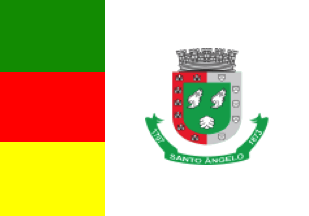 image by Ivan Sache, 4 March
2020
image by Ivan Sache, 4 March
2020
Last modified: 2020-08-08 by ian macdonald
Keywords: rio grande do sul | santo Ângelo |
Links: FOTW homepage |
search |
disclaimer and copyright |
write us |
mirrors
 image by Ivan Sache, 4 March
2020
image by Ivan Sache, 4 March
2020
The municipality of Santo Ângelo (76,275 inhabitants in 2010; 68,050 ha) is
located 460 km of Porto Alegre. The municipality is composed of the districts of
Santo Ângelo (seat), Buriti (est. by Municipal Law No. 7 promulgated on 17 July
1956), Comandaí (est. by Municipal Law No. 410 promulgated on 19 December 1978),
Colônia Municipal (est. by Municipal Law No. 410 promulgated on 19 December
1978), Rincão dos Mendes (est. by Municipal Law No. 688 promulgated on 20 May
1982), Restinga Seca (est. by Municipal Law No. 815 promulgated on 25 September
1984), Lajeado do Cerne (est. by Municipal Law No. 815 promulgated on 25
September 1984), Atafona (est. by Municipal Law No. 1,103 promulgated on 9
August 1988), Ressaca da Buriti (est. by Municipal Law No. 1,402 promulgated on
25 July 1991), Cristo Rei (est. by Municipal Law No. 1,466 promulgated on 26
December 1991), Sossego (est. by Municipal Law No. 1,636 promulgated on 12 April
1993), Rincão dos Rorattos (est. by Municipal Law No. 1,636 promulgated on 12
April 1993), União (est. by Municipal Law No. 1,636 promulgated on 12 April
1993), Lajeado Micium (est. by Municipal Law No. 1,785 promulgated on 29 March
1994), and Rincão dos Meotti (est. by Municipal Law No. 2,566 promulgated on 27
August 2002).
Santo Ângelo was established in 12 August 1706 by the
Jesuit missionary Diogo de Haze as a reduction dedicated to the Missions'
Custodian Angel (Santo Ângelo Custódio). The seventh of the Seven Missions'
Settlements, it was originally established near the confluence of rivers Ijuí
and Ijuizinho and transferred in 1707 to the today's historical downtown. A
flourishing mission counting up to 8,000 inhabitants, the town was destroyed in
1756 during the War of the Seven Reductions.
The municipality of Santo Ângelo
was established by Law no. 835 promulgated on 22 March 1873, separating from
Cruz Alta.
https://pmsantoangelo.abase.com.br/
Municipal website
Ivan Sache, 4 August 2020
Divided vertically 1:2, the narrow stripe divided horizontally
green-red-yellow, and the white field bearing the municipal arms.
Dirk Schönberger,
26 March 2012
The flag of Santo Ângelo is prescribed by Municipal Law No. 40 promulgated on
12 April 1972.
Article 1.
The municipal flag has for symbol the coat
of arms of Santo Ângelo in its simplified version, located in the center of the
2/3 of the rectangle (argent), representing candor, the first rectangular third
being made of the three stripes of the Ragamuffin flag.
a) 1st third, first
stripe: vert (green), meaning abundance; second stripe, gules (red), meaning
intrepidity; third stripe, golden yellow, meaning force.
b) the town's coat
of arms in the center of the 2/3 white, meaning candor, in its simplified
version, whose heraldic description is the following: A Portuguese shield, vert
two wing stumps argent in chief a scallop of the same in base. A bordure per
pale, 1. Red seven castles or masoned black, 2. Argent five blue escutcheons
each charged with five bezants argent. The shield surmounted by a five-towered
mural crown argent. A green scroll charged with the municipality's name argent
surrounded by the dates "1707" and "1873" of the same.
Article 2.
The
green field represents the municipality's natural resources and recalls that
Santo Ângelo was the only reduction to have production of mate as its source of
income. The wings and the scallop symbolize the missionary settlements
established on the municipal territory, Santo Ângelo, São Miguel (the two
angel's wings) and São João (the baptismal scallop). The municipal territory was
located at the front of political expansion of Spain and Portugal, as recalled
by the divided border charged dexter with seven castles and sinister with five "quinas",
the heraldic symbols of the two peninsular kingdoms. The scroll is inscribed
with the date of foundation of the missionary settlement and of municipal
emancipation. The mural crown indicates the rank of "cidade" and municipal seat.
https://www2.leismunicipais.com.br/leismunicipais/originais/rs/santo-angelo/lei-ordinaria-40-1972.pdf
Leis Municipais database
The coat of arms of Santo Ângelo is
prescribed by Municipal Law No. 2 promulgated on 7 April 1965.
Article 1.
Portuguese shield, green two wing stumps argent in chief a scallop of the same
in base. A bordure per pale, 1. Red seven castles or masoned black, 2. Argent
five blue escutcheons each charged with five bezants argent. The shield
surmounted by a five-towered mural crown argent. A green scroll charged with the
municipality's name argent surrounded by the dates "1707" and "1873" of the
same.
Article 2.
The green field represents the municipality's natural
resources and recalls that Santo Ângelo was the only reduction to have
production of mate as its source of income. The wings and the scallop symbolize
the missionary settlements established on the municipal territory, Santo Ângelo,
São Miguel (the two angel's wings) and São João (the baptismal scallop). The
municipal territory was located at the front of political expansion of Spain and
Portugal, as recalled by the divided border charged dexter with seven castles
and sinister with five "quinas", the heraldic symbols of the two peninsular
kingdoms. The scroll is inscribed with the date of foundation of the missionary
settlement and of municipal emancipation. The mural crown indicates the rank of
"cidade" and municipal seat.
https://www2.leismunicipais.com.br/leismunicipais/originais/rs/santo-angelo/lei-ordinaria-2-1965.pdf
Leis Municipais database
Photos
https://www.facebook.com/prefeituramunicipaldesantoangelo/photos
https://www.facebook.com/prefeituramunicipaldesantoangelo/photos
https://www.facebook.com/prefeituramunicipaldesantoangelo/photos
https://www.facebook.com/prefeituramunicipaldesantoangelo/photos
https://www.facebook.com/prefeituramunicipaldesantoangelo/photos
Ivan Sache, 4 August 2020